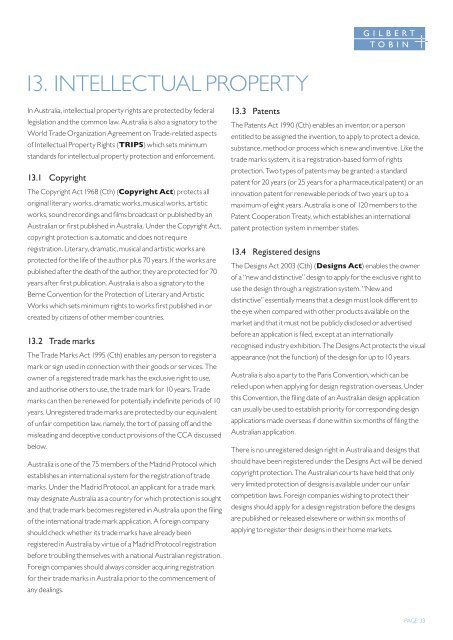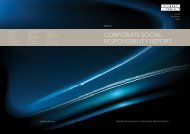Gilbert + tobin - Gilbert and Tobin
Gilbert + tobin - Gilbert and Tobin
Gilbert + tobin - Gilbert and Tobin
Create successful ePaper yourself
Turn your PDF publications into a flip-book with our unique Google optimized e-Paper software.
13. Intellectual property<br />
In Australia, intellectual property rights are protected by federal<br />
legislation <strong>and</strong> the common law. Australia is also a signatory to the<br />
World Trade Organization Agreement on Trade-related aspects<br />
of Intellectual Property Rights (TRIPS) which sets minimum<br />
st<strong>and</strong>ards for intellectual property protection <strong>and</strong> enforcement.<br />
13.1 Copyright<br />
The Copyright Act 1968 (Cth) (Copyright Act) protects all<br />
original literary works, dramatic works, musical works, artistic<br />
works, sound recordings <strong>and</strong> films broadcast or published by an<br />
Australian or first published in Australia. Under the Copyright Act,<br />
copyright protection is automatic <strong>and</strong> does not require<br />
registration. Literary, dramatic, musical <strong>and</strong> artistic works are<br />
protected for the life of the author plus 70 years. If the works are<br />
published after the death of the author, they are protected for 70<br />
years after first publication. Australia is also a signatory to the<br />
Berne Convention for the Protection of Literary <strong>and</strong> Artistic<br />
Works which sets minimum rights to works first published in or<br />
created by citizens of other member countries.<br />
13.2 Trade marks<br />
The Trade Marks Act 1995 (Cth) enables any person to register a<br />
mark or sign used in connection with their goods or services. The<br />
owner of a registered trade mark has the exclusive right to use,<br />
<strong>and</strong> authorise others to use, the trade mark for 10 years. Trade<br />
marks can then be renewed for potentially indefinite periods of 10<br />
years. Unregistered trade marks are protected by our equivalent<br />
of unfair competition law, namely, the tort of passing off <strong>and</strong> the<br />
misleading <strong>and</strong> deceptive conduct provisions of the CCA discussed<br />
below.<br />
Australia is one of the 75 members of the Madrid Protocol which<br />
establishes an international system for the registration of trade<br />
marks. Under the Madrid Protocol, an applicant for a trade mark<br />
may designate Australia as a country for which protection is sought<br />
<strong>and</strong> that trade mark becomes registered in Australia upon the filing<br />
of the international trade mark application. A foreign company<br />
should check whether its trade marks have already been<br />
registered in Australia by virtue of a Madrid Protocol registration<br />
before troubling themselves with a national Australian registration.<br />
Foreign companies should always consider acquiring registration<br />
for their trade marks in Australia prior to the commencement of<br />
any dealings.<br />
13.3 Patents<br />
The Patents Act 1990 (Cth) enables an inventor, or a person<br />
entitled to be assigned the invention, to apply to protect a device,<br />
substance, method or process which is new <strong>and</strong> inventive. Like the<br />
trade marks system, it is a registration-based form of rights<br />
protection. Two types of patents may be granted: a st<strong>and</strong>ard<br />
patent for 20 years (or 25 years for a pharmaceutical patent) or an<br />
innovation patent for renewable periods of two years up to a<br />
maximum of eight years. Australia is one of 120 members to the<br />
Patent Cooperation Treaty, which establishes an international<br />
patent protection system in member states.<br />
13.4 Registered designs<br />
The Designs Act 2003 (Cth) (Designs Act) enables the owner<br />
of a “new <strong>and</strong> distinctive” design to apply for the exclusive right to<br />
use the design through a registration system. “New <strong>and</strong><br />
distinctive” essentially means that a design must look different to<br />
the eye when compared with other products available on the<br />
market <strong>and</strong> that it must not be publicly disclosed or advertised<br />
before an application is filed, except at an internationally<br />
recognised industry exhibition. The Designs Act protects the visual<br />
appearance (not the function) of the design for up to 10 years.<br />
Australia is also a party to the Paris Convention, which can be<br />
relied upon when applying for design registration overseas. Under<br />
this Convention, the filing date of an Australian design application<br />
can usually be used to establish priority for corresponding design<br />
applications made overseas if done within six months of filing the<br />
Australian application.<br />
There is no unregistered design right in Australia <strong>and</strong> designs that<br />
should have been registered under the Designs Act will be denied<br />
copyright protection. The Australian courts have held that only<br />
very limited protection of designs is available under our unfair<br />
competition laws. Foreign companies wishing to protect their<br />
designs should apply for a design registration before the designs<br />
are published or released elsewhere or within six months of<br />
applying to register their designs in their home markets.<br />
PAGE 33







